Agriculture Reference
In-Depth Information
(a)
(b)
(c)
Figure 18.21
(a) vine weevil larva and pupa; (b) vine weevil adult; (c) adult vine weevil damage: on grape leaf
Lily beetle (
Lilioceris lilii
)
adults with two pairs of translucent wings, and with
the fore wings and hind wings being locked together
by fine hooks. The slender waist-like first segments
of the abdomen give these adults a characteristic
appearance. Adult sawflies resemble flying ants.
Sawfly larvae in many species resemble moth
caterpillars (see Figure 18.10), but some such as
pear
slugworm
(
Caliroa cerasi
)
are black, have no visible
legs and look rather slug like.
Gooseberry sawfly (
Nematus ribesii
)
is an
important pest on gooseberries, redcurrants
and white currants, but not on blackcurrants.
Extensive damage to foliage may be caused by the
caterpillars, often leaving only the main leaf veins
(Figure 18.23). The green caterpillars with black
spots are easily recognized. Often three life cycles
per year occur. Picking-off caterpillars in spring is
recommended. Sprays containing
pyrethrum
are
effective.
Large rose sawfly (
Arge pargana
)
caterpillars,
skeletonizing rose leaves are controlled by sprays
containing
deltamethrin
.
New sawfly problem
.
Berberis sawfly
(
Arge
berberidis
) has recently spread to many parts of
the UK. It defoliates the leaves of
Berberis
and
Mahonia.
Ants.
Two species, the
black ant
(
Lasius niger
) and
the
red ant
(
Myrmica rubra
) may commonly be seen
in UK gardens. They encourage aphids that produce
honeydew (see p. 233).
Ant nests
located in lawn
areas spoil the appearance of the turf. Removal of the
ant nest avoids chemical control, but nests may re-
establish fairly quickly. Pyrethrin products containing
ingredients such as
permethrin
are commonly used
as dusts to control ants.
Springtails (order Collembola)
are wingless insects,
2 mm in length, that are very common in soils, and
This small beetle has steadily increased in numbers
since 1940 in the southern Britain and Ireland, recently
reaching parts of northern England, central Scotland and
Northern Ireland. The adult is bright red; its head and
legs are black; and it is 8 mm in length (Figure 18.22b).
The larvae often have a dark slimy appearance, and are
8-10 mm in length, orange in colour, with black heads.
Adults and larvae defoliate a wide range of lilies and
fritillaries.
Deltamethrin
sprays may be used. A parasitic
wasp (
Lemophagus arrabundus
), present in mainland
Europe, has not yet established in Britain and Ireland.
Other beetle pests
Springtime attack of
flea beetle
(
Phyllotreta
species,
3 mm long, black in colour, some with a yellow stripe)
on leaves of young cruciferous plants (e.g. cabbages
and stocks) may become serious. Horticultural fleece
draped over young brassicas helps in control (see
Figure 18.22a).
In
recent years
in the UK, three other increasingly
common beetle problems have been reported. The
viburnum beetle
(
Pyrrhalta viburni
, 5 mm long, light
brown in colour) is found on
Viburnum opulus
,
V. tinus
and
V
.
lantana.
The
rosemary leaf beetle
(
Chrysolina
americana
, 8 mm long, metallic green with purple
stripes) occurs on lavender, rosemary and thyme.
The
asparagus beetle
(
Crioceris asparagi
, 7 mm
long, metallic black body with four white spots) is
becoming more common. Chemical sprays containing
ingredients such as
pyrethrum
or
deltametrin
are
sometimes used against these new pests.
18
Sawflies
Sawfiles, together with bees, wasps and ants, are
classified in the order
Hymenoptera
, which have















